


- bo·tan·i·cal:
- 1. Of or relating to plants or plant life. adj.
- 2. Of or relating to the science of botany. adj.
- 3. A drug, medicinal preparation, or similar substance obtained from a plant or plants. n.
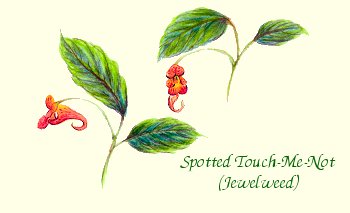 The Spotted Touch-Me-Not or Jewelweed is in the impatiens family. It grows in the shady moist areas. It blooms from June until frost. This is the speckled yellow-orange varity that is found around my house. The seed pods, as they become dry, will explode at a touch and scatter the seeds. Jewelweed is one plant whose blooming time is closely followed by the Ruby-throated hummingbird, especially the Spotted Touch-Me-Not (Impatiens capensis) species. This plant blooms several weeks later than its cousin, Impatiens pallida, which is pollinated primarily by bees. Ruby-throated hummingbirds rely on spotted touch-me-nots as a source of nectar as they migrate south, and it could be that the later time of blooming has been an adaption of this species to take advantage of hummingbirds as pollinators.
The Spotted Touch-Me-Not or Jewelweed is in the impatiens family. It grows in the shady moist areas. It blooms from June until frost. This is the speckled yellow-orange varity that is found around my house. The seed pods, as they become dry, will explode at a touch and scatter the seeds. Jewelweed is one plant whose blooming time is closely followed by the Ruby-throated hummingbird, especially the Spotted Touch-Me-Not (Impatiens capensis) species. This plant blooms several weeks later than its cousin, Impatiens pallida, which is pollinated primarily by bees. Ruby-throated hummingbirds rely on spotted touch-me-nots as a source of nectar as they migrate south, and it could be that the later time of blooming has been an adaption of this species to take advantage of hummingbirds as pollinators.
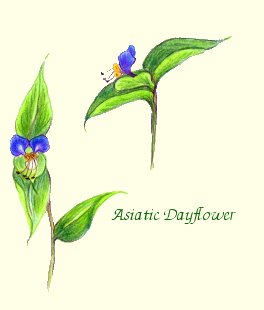 This is the Asiatic Dayflower (Commelina communis).The Asiatic Dayflower was not a native species to this country, but has become common after escaping after being brought to this country. These flowers open up and bloom everyday, with each bloom lasting but one day. You can see that the blue flower grows out of a pod that is very much like a venus fly trap opening. This imported plant (from Asia, as its common name shows) is a pest to gardeners, and a rabid invader of other plants' space. Its lovely blue flowers make it tolerable in small doses, but it is rare to get dayflowers in small doses. As its genus, communis, suggests, it froms huge spindly "communities," which choke other plants, and return in full force year after year.
This is the Asiatic Dayflower (Commelina communis).The Asiatic Dayflower was not a native species to this country, but has become common after escaping after being brought to this country. These flowers open up and bloom everyday, with each bloom lasting but one day. You can see that the blue flower grows out of a pod that is very much like a venus fly trap opening. This imported plant (from Asia, as its common name shows) is a pest to gardeners, and a rabid invader of other plants' space. Its lovely blue flowers make it tolerable in small doses, but it is rare to get dayflowers in small doses. As its genus, communis, suggests, it froms huge spindly "communities," which choke other plants, and return in full force year after year.
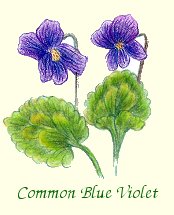 The Common Blue Violet (Viola papilionacea) can be violet, lavender, or white with purplish veins. The white variety is not the same as the White Violet (Viola blanda).
The Common Blue Violet (Viola papilionacea) can be violet, lavender, or white with purplish veins. The white variety is not the same as the White Violet (Viola blanda).
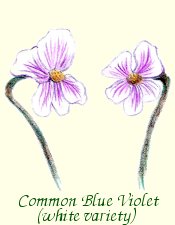 More than color is needed to identify a violet species, since there are around 900 species found throughout the world. The Common Blue blooms from March to mid-May around here. It is a 5 petaled small, 1/2" to 3/4", flower with leaves on separate stalks. The plant is short and thick with leaves which grows low to the ground, not more than 12 inches high. If left alone, they will fill in nicely and make very pretty groundcover. I have pulled weeds from around them and they have filled in on both sides of my driveway and look great from early spring through to the winter. Interestingly, on one side of the drive the violet-colored variety grows, and on the otherside is the white variety. I'm not sure why this happened, but it looks beautiful in the spring! Violet leaves are high in vitamin A and C and can be used in salads or cooked as greens. The flowers can be made into candies and jellies too. But I think I will stick with berries for "food from the wild".
More than color is needed to identify a violet species, since there are around 900 species found throughout the world. The Common Blue blooms from March to mid-May around here. It is a 5 petaled small, 1/2" to 3/4", flower with leaves on separate stalks. The plant is short and thick with leaves which grows low to the ground, not more than 12 inches high. If left alone, they will fill in nicely and make very pretty groundcover. I have pulled weeds from around them and they have filled in on both sides of my driveway and look great from early spring through to the winter. Interestingly, on one side of the drive the violet-colored variety grows, and on the otherside is the white variety. I'm not sure why this happened, but it looks beautiful in the spring! Violet leaves are high in vitamin A and C and can be used in salads or cooked as greens. The flowers can be made into candies and jellies too. But I think I will stick with berries for "food from the wild".
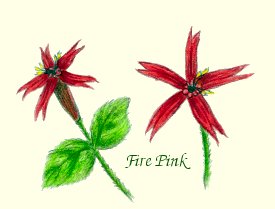 The Fire Pink (Silene virginica), inspite of its name, is actually red. It is in the Pink or Carnation family, and it is one of the approximately 2,000 species found primarily in the Northern Hemisphere. They are especially found in cool regions, and I hope this to be true come summer time. They bloom from April to June in open woods, thickets, and rocky slopes. I know this is true here, because you practically have to be a mountain goat to get to them. The Fire Pink is a very easy to identify flower, with its vivid red color and distinctive shape. A common name for members of this genus is Catchfly which refers to their having hairy, sticky stems and leaves. However, these plants do not eat insects. Their stickiness keeps crawling insects from the flowers, and thus facilitates cross-pollination by airborne insects.
The Fire Pink (Silene virginica), inspite of its name, is actually red. It is in the Pink or Carnation family, and it is one of the approximately 2,000 species found primarily in the Northern Hemisphere. They are especially found in cool regions, and I hope this to be true come summer time. They bloom from April to June in open woods, thickets, and rocky slopes. I know this is true here, because you practically have to be a mountain goat to get to them. The Fire Pink is a very easy to identify flower, with its vivid red color and distinctive shape. A common name for members of this genus is Catchfly which refers to their having hairy, sticky stems and leaves. However, these plants do not eat insects. Their stickiness keeps crawling insects from the flowers, and thus facilitates cross-pollination by airborne insects.
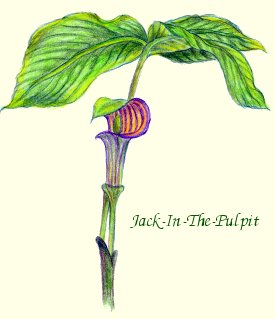 This wildflower, Jack-In-The-Pulpit (Arisaema triphyllum) was the very first true wildflower that I spotted after I moved here. I remember being so excited about spotting it because I had never seen one before. It is in the Arum family, in which the members are considered herbs. The Arum family also includes popular houseplants such as philodendrons, Calla Lilies, and caladiums. Jacks are found in damp woods or swamp areas and are about 1 to 3 feet tall. They have tiny red berries on the spadix (spike in center of pulpit) in late summer and fall. Some experts recognize one species, and others three, based on minor differences in leaves, spathe, and size. The Jack-In-The-Pulpit attracts mosquitoes with its smell of a stagnant pool. Lovely... It has an underground tuber that is peppery to the taste and causes a burning reaction if eaten raw. This can be eliminated by cooking, but I think I will stick with potatos for my eatting tubers.
This wildflower, Jack-In-The-Pulpit (Arisaema triphyllum) was the very first true wildflower that I spotted after I moved here. I remember being so excited about spotting it because I had never seen one before. It is in the Arum family, in which the members are considered herbs. The Arum family also includes popular houseplants such as philodendrons, Calla Lilies, and caladiums. Jacks are found in damp woods or swamp areas and are about 1 to 3 feet tall. They have tiny red berries on the spadix (spike in center of pulpit) in late summer and fall. Some experts recognize one species, and others three, based on minor differences in leaves, spathe, and size. The Jack-In-The-Pulpit attracts mosquitoes with its smell of a stagnant pool. Lovely... It has an underground tuber that is peppery to the taste and causes a burning reaction if eaten raw. This can be eliminated by cooking, but I think I will stick with potatos for my eatting tubers.
The following is an excerpt from Don Blanding's poem "House in a Hammock". It sums up the feelings of taking a hike and walking slowly so that you see all that is there.
In a setting of amber and sable and green,
Where the cycle of life is revealed to our eyes
On the stage of the forest, the earth and the skies,
The pattern of growth in the shell of a seed,
The wisdom of roots in the search for their need,
The climb of the sprout, the strength of the tree,
The leaf that unfolds, the bud breaking free
From its guardian sheath, and the blossom that calls
To the bees and the moths, the ripe fruit that falls
And the seed that returns to the flesh of the earth
To renew the old drama of death and of birth."

References
- "Field Guide to North American Wildflowers" Eastern Region published by the National Audubon Society
- "North American Wildlife" published by Reader's Digest
- "Eastern Forests" published by the National Audubon Society
- "Medicinal Plants and Herbs" Eastern/Central by Steven Foster and James A. Duke (Peterson Field Guide)
- "Wildflowers of the Smokies" published by Great Smoky Mountains Association




Home
Site Map
Email at: dh @ naturehaven.com
(Take out the spaces and this email address will work!)
Please Read Guestbook ~~~ Please Sign Guestbook


